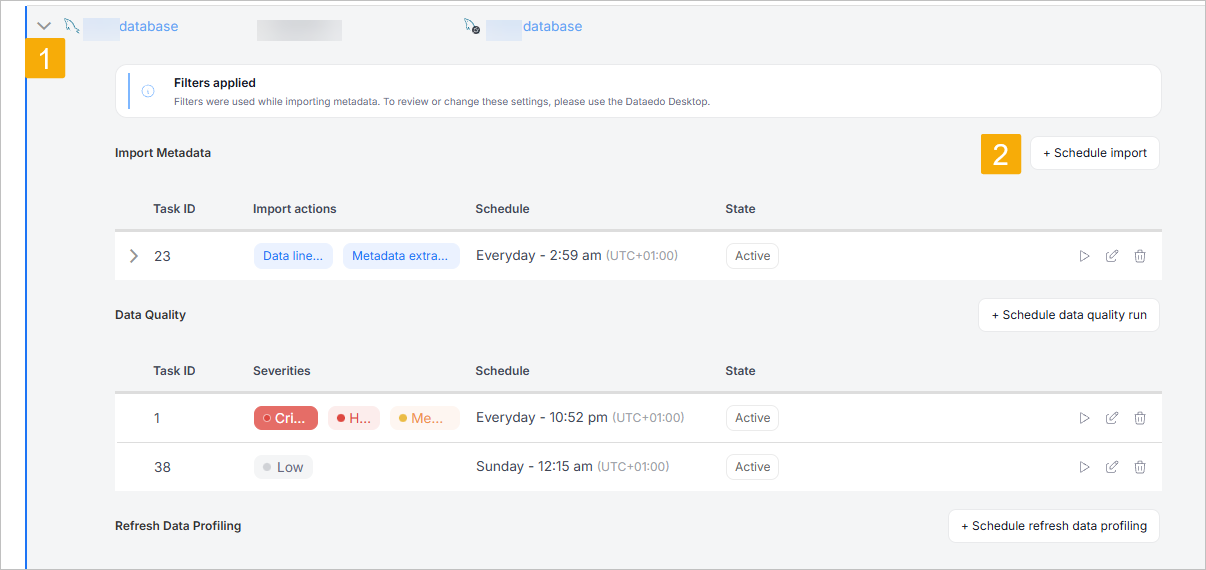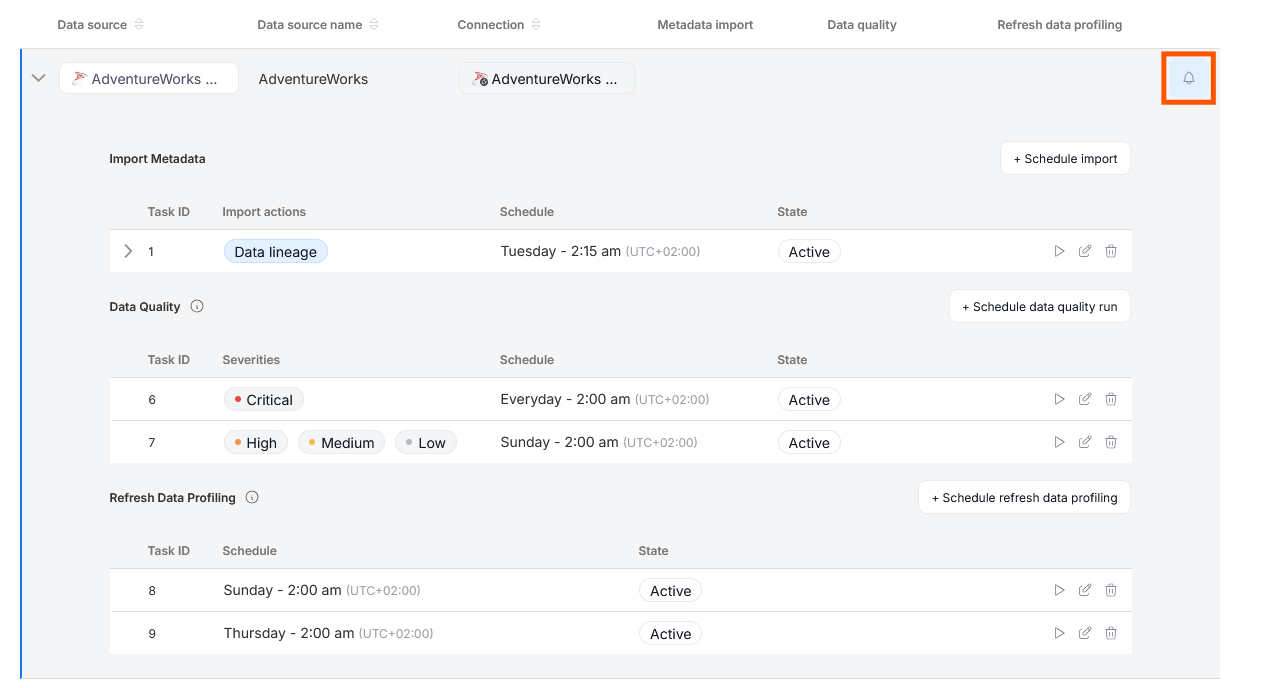Scheduling Tasks in Dataedo Portal
This guide outlines how to manage task scheduling using the Scheduler, Connections, and Credentials views available under the Connectors section in the Portal.
Note that only users with the Connection Manager role can access the Connectors section and perform actions described here.
Connectors Overview
Under the Connectors section in the Portal, you can manage:
- Connections – connection configurations for Data Sources.
- Credentials – reusable authentication details shared across Connections.
- Schedule – task scheduling interface with logs and calendar.
Connections
Each Connection is linked to exactly one Data Source. Connections group shared configuration settings like Credentials, host, and port, making it easier to manage and reuse across environments.
While currently in version 25.2 each Connection maps to a single Data Source, future versions will allow sharing Connections across multiple sources.
Accessing Connections
Navigate to Connectors > Connections to see all configured Connections. You can:
- View Connections as tiles or in a grid.
- Filter by connector type, category, or Connection/Data Source name.
- Search for specific Connections.
- Check scheduled tasks in the Scheduled tasks column.
- Select a Connection name to view more details.

Connection Details
When you select a Connection, you can access two tabs:
- Task Planner – manage tasks for that Connection (same interface as in Scheduler).
- Settings – view/edit Connection details and manage Credentials.
In the Settings tab, you can:
- Update Connection parameters.
- Assign or create Credentials.
- Test the Connection to verify access.
Note that you cannot add new Connections in version 25.2. This means that the initial metadata import still needs to be done in Dataedo Desktop.
Credentials
Credentials store sensitive information like passwords, API keys, or tokens. These Credentials are grouped by connector type and can be reused across multiple Connections using the same connector.
A single Credentials entry can be used across multiple Connections of the same connector type. This allows for centralized credential management since if the password or token changes, you only need to update it once.
Managing Credentials
Go to Connectors > Credentials to:
- View a list of existing Credentials.
- Filter by credential name or connector type.
- Add new Credentials.
- Edit or delete existing Credentials.

To add credentials:
- Select Add credentials.
- Choose a connector.
- Enter a title.
- Click Create credentials.
To edit or delete credentials:
- Use the three-dot menu in the Credentials list.
- Select Edit or Delete.
- If a Credential is used by any Connection, you’ll be prompted to reassign another Credential before deletion.
Important: You cannot view password-like values (for example., passwords, API tokens) after they are saved. The Portal does not function as a password manager, although non-sensitive fields like usernames remain visible.
Scheduler
The Scheduler is available under Connectors > Schedule and consists of two main tabs:
- Task Planner – create and manage scheduled tasks.
- Calendar – view task execution history and upcoming executions.

Task Planner
Use the Task Planner tab to schedule, edit, delete, or run tasks for your Data Sources.
Features
- Tasks are grouped by Data Source.
- Filter tasks by connector or task type.
- Use the search bar to find tasks.
Task Status
- Active – the task will be executed according to its schedule.
- Draft – the task will not be executed until manually activated.
To Schedule a Task
- Select the Data Source.
- Click the scheduling button on the right.

You can specify:
- Task type (for example, Import, Data Quality, Profiling).
- Execution frequency:
- Daily at a specific time.
- Specific days of the week.
- Specific days of the month.
- Status: Draft or Active.
Note: Tasks use the creator’s local time zone for scheduling, but are displayed in UTC in the interface.
Limitation: Tasks requiring Browser login cannot be scheduled.
To Edit a Task
- Locate the task.
- Click the Edit icon in the task row.
- Modify task settings and save.

To Immediately Execute a Task
- Find the task.
- Click the Trigger now icon.

Note: The task will be added to the queue immediately, but actual execution may be delayed. The Agent can only process one task at a time and must finish the current task before starting a new one.
To Remove a Task
- Find the task.
- Click the Remove icon.

Warning: Not all Data Sources support Data Quality or Data Profiling tasks. These task types will not be available for unsupported sources.
Calendar
The Calendar tab displays task execution logs, including:
- Past executions.
- Ongoing executions.
- Future (planned) executions.

Search and Filter
You can filter executions by:
- Progress status: Past, In Progress, Upcoming.
- Execution status: All, Failed.
- Connector.
- Task type.
Tasks are grouped by execution ID. You can also search by Data Source name.
Note: Future tasks are based on estimated execution time. Actual times may vary depending on system load and Agent capacity.
Execution History
Each execution includes a log history. If an error occurs, detailed information and a stack trace are available to help with troubleshooting.
To view details for a failed task, click the error icon in the Calendar tab. A popup will show the error message and stack trace, which can be sent to support if needed.
Scheduled tasks notifications
Enabling notifications from the scheduler simply serves as a shortcut. Following the object normally will still subscribe you to notifications regarding its task, provided your account settings allow for that.
You can enable notifications for your scheduled tasks directly from the Scheduler's level. Simply press on the bell icon next to an object for which a task was scheduled. If your notification settings allow that, you will receive notifications regarding that tasks errors or failures via e-mail and the Portal.

The notification system and configuring your notifications is explained in more depth in our dedicated article.
Agent Status Indicators
Banners may appear in the Scheduler or Calendar views to indicate issues with the Agent:
- Agent not installed.
- Agent version mismatch.
- Agent cannot connect to the repository (for example, due to firewall or configuration issues).

